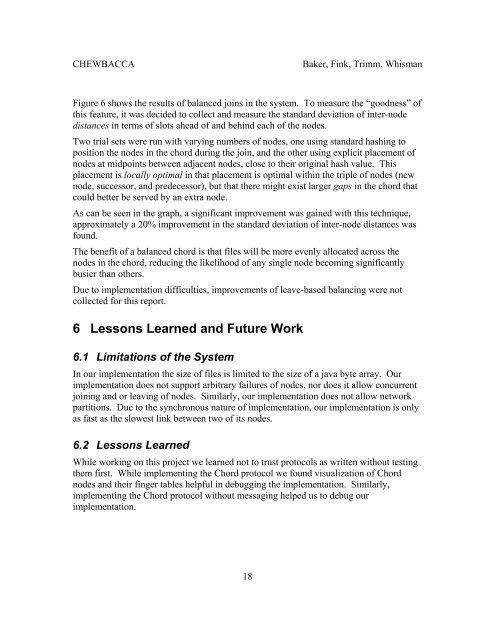Implementing a Distributed Peer to Peer File Sharing System ... - Umbc
Implementing a Distributed Peer to Peer File Sharing System ... - Umbc
Implementing a Distributed Peer to Peer File Sharing System ... - Umbc
You also want an ePaper? Increase the reach of your titles
YUMPU automatically turns print PDFs into web optimized ePapers that Google loves.
CHEWBACCA Baker, Fink, Trimm, Whisman<br />
Figure 6 shows the results of balanced joins in the system. To measure the “goodness” of<br />
this feature, it was decided <strong>to</strong> collect and measure the standard deviation of inter-node<br />
distances in terms of slots ahead of and behind each of the nodes.<br />
Two trial sets were run with varying numbers of nodes, one using standard hashing <strong>to</strong><br />
position the nodes in the chord during the join, and the other using explicit placement of<br />
nodes at midpoints between adjacent nodes, close <strong>to</strong> their original hash value. This<br />
placement is locally optimal in that placement is optimal within the triple of nodes (new<br />
node, successor, and predecessor), but that there might exist larger gaps in the chord that<br />
could better be served by an extra node.<br />
As can be seen in the graph, a significant improvement was gained with this technique,<br />
approximately a 20% improvement in the standard deviation of inter-node distances was<br />
found.<br />
The benefit of a balanced chord is that files will be more evenly allocated across the<br />
nodes in the chord, reducing the likelihood of any single node becoming significantly<br />
busier than others.<br />
Due <strong>to</strong> implementation difficulties, improvements of leave-based balancing were not<br />
collected for this report.<br />
6 Lessons Learned and Future Work<br />
6.1 Limitations of the <strong>System</strong><br />
In our implementation the size of files is limited <strong>to</strong> the size of a java byte array. Our<br />
implementation does not support arbitrary failures of nodes, nor does it allow concurrent<br />
joining and or leaving of nodes. Similarly, our implementation does not allow network<br />
partitions. Due <strong>to</strong> the synchronous nature of implementation, our implementation is only<br />
as fast as the slowest link between two of its nodes.<br />
6.2 Lessons Learned<br />
While working on this project we learned not <strong>to</strong> trust pro<strong>to</strong>cols as written without testing<br />
them first. While implementing the Chord pro<strong>to</strong>col we found visualization of Chord<br />
nodes and their finger tables helpful in debugging the implementation. Similarly,<br />
implementing the Chord pro<strong>to</strong>col without messaging helped us <strong>to</strong> debug our<br />
implementation.<br />
18











